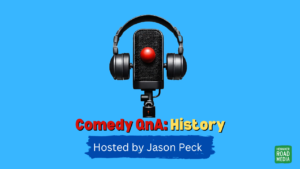It occurs to me that over the past couple of months I’ve been talking about Public Speaking and Mind Mapping without actually talking about the process that you go through in order to create a Mind Map.
Waaaaay back in the early 1990s, I taught myself Mind Mapping by reading the book by Tony Buzan entitled “Use Your Head” and also watching the video “Get Ahead”. Aah, VHS video those were the days. (If you still have the facility to play dead technology, like I do – just – check out the link).
Anyway, here’s a quick “cheat sheet” version of how to create a Mind Map (apologies to my Mind Map-enabled readers for teaching you how to suck eggs straight out the chicken).
1. Start with a central image that’s representative of your topic. You can also add a keyword to that image so that it appeals to your left-brain and not just your right.
2. Next create some branches which contain keywords relating to your central idea. For instance, if your central idea is comedians then your initial branches might be types of comedian; stand-up, sketch, print and movie. These branches should only contain one keyword and be printed. I always do mine in capitals.
3. The next set of branches, the sub-branches if you will, will contain a little bit more detail. So using the above example branching off from Stand-up you could have clean and blue.
4. From each of those sub-branches you create further branches which contain the detail. You can also use more than just a keyword on these branches. Continuing with our previous theme from the “clean” you could have Jerry Seinfeld, Steve Martin, etc.
5. Each of the branches should contain lots of vibrant colours. For a visual guide, take a look at the Mind Map I included on my earlier post Creating Killer Content Off The Cuff, part 3. Colours help to stimulate the memory (specifically the right brain) and are appealing to the eye.
6. You should also include symbols and images that relate to some of the keywords you’ve written on your Mind Map. For instance, in my stand-up example here I’d maybe include a microphone as they are pretty synonymous with that artform. I might even include the word stand-up.
Mind Maps work by appealing to both sides of your brain and using your whole brain to help you memorise information. What do I mean by that? Well, there has been lots of scientific research which tells us that each side of our brain has different functions. For instance, the left-hand side of the brain is responsible for logic, words and numbers. Whereas the right-hand side of the brain is responsible for colour, day-dreaming and imagination.
So you can already see that Mind Maps are appealing to both sides of the brain because they use words (left side) and colour (right side). They integrate brain functions in a pretty groovy way.
They’re a great tool for creating speeches because you essentially get to brain storm all your ideas down on to a single sheet of paper. This allows you to see the connections between ideas and lets you literally connect them by using arrows around the outside of your branches.
If you have the opportunity to develop a speech over a period of time, you can continually add more details and other ideas to your Mind Map. They can expand and grow over time.
From there, what you can do is decide where you want to start and put a circle around your completed branches and number them so you can see the order.
If you decide that the way you’ve mind mapped your idea has the basis of your speech out of chronological order, you can simply re-mind map the topic putting it into the correct order.
The best way I find to work my mind maps is by following them around clockwise beginning in the top right-hand corner. Whatever’s in that corner is the beginning of my speech. Have a quick look at the other mind map in my post Creating Killer Content Off The Cuff, part 1.
This allows you to take the non-linear method of mind maps and turn them into the linear form of a speech. What I did way back when was to begin on one side of the Mind Map and follow round in a circle clockwise making sure that when I spoke that I dealt with the points that I had outlined. If you want to script it, then talk it onto a dictaphone perhaps and then write it down from there. Or simply talk out loud and write it down.
If you’re new to this then, give it a try and feedback in the comments section how you got on.




2 comments
1 pings
I went through this in a Dale Carnegie class a few years back. I think it was called “pegging”. And, it was basically the same thing, where you associate items, etc with images.
Sort of like making a grocery list with the items as images. Then you just recall the images.
Plus, the images went together like a story. Pretty cool, and I could do it for about 1 week.
But, if you don’t use it, you lose it. And, I lost it 🙁
Good article!
Mike
Author
Hey Mike,
Thanks for dropping by. You’re absolutely right. I didn’t mind map for a period of time and as a result i lost it. when i revisited though and referred to some of my books i soon picked it back up. it’s like riding a bike, all the groundwork’s been done you’ve just got to try it again in order for it to come flooding back.
Pegging is a basic memory technique. i’ve tried a couple of the years, but i use this one mainly because i enjoy the creativity of it. there is a form of pegging involved when you create a mind map because you are pegging images and words together.
i’d actually like to revisit some of the other memory technqiues at some point because there’ll always be useful.
try mind mapping as a technique. it’s a tool that you can experiment with and learn the rules. once you’ve done that you can bend them and make them your own.
Cheers
[…] Read the rest of this great post here […]